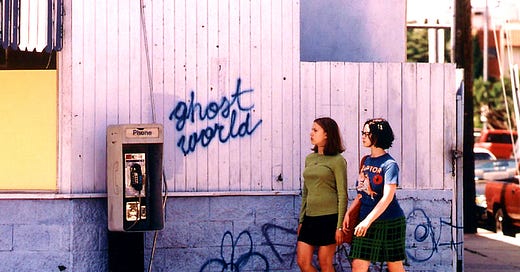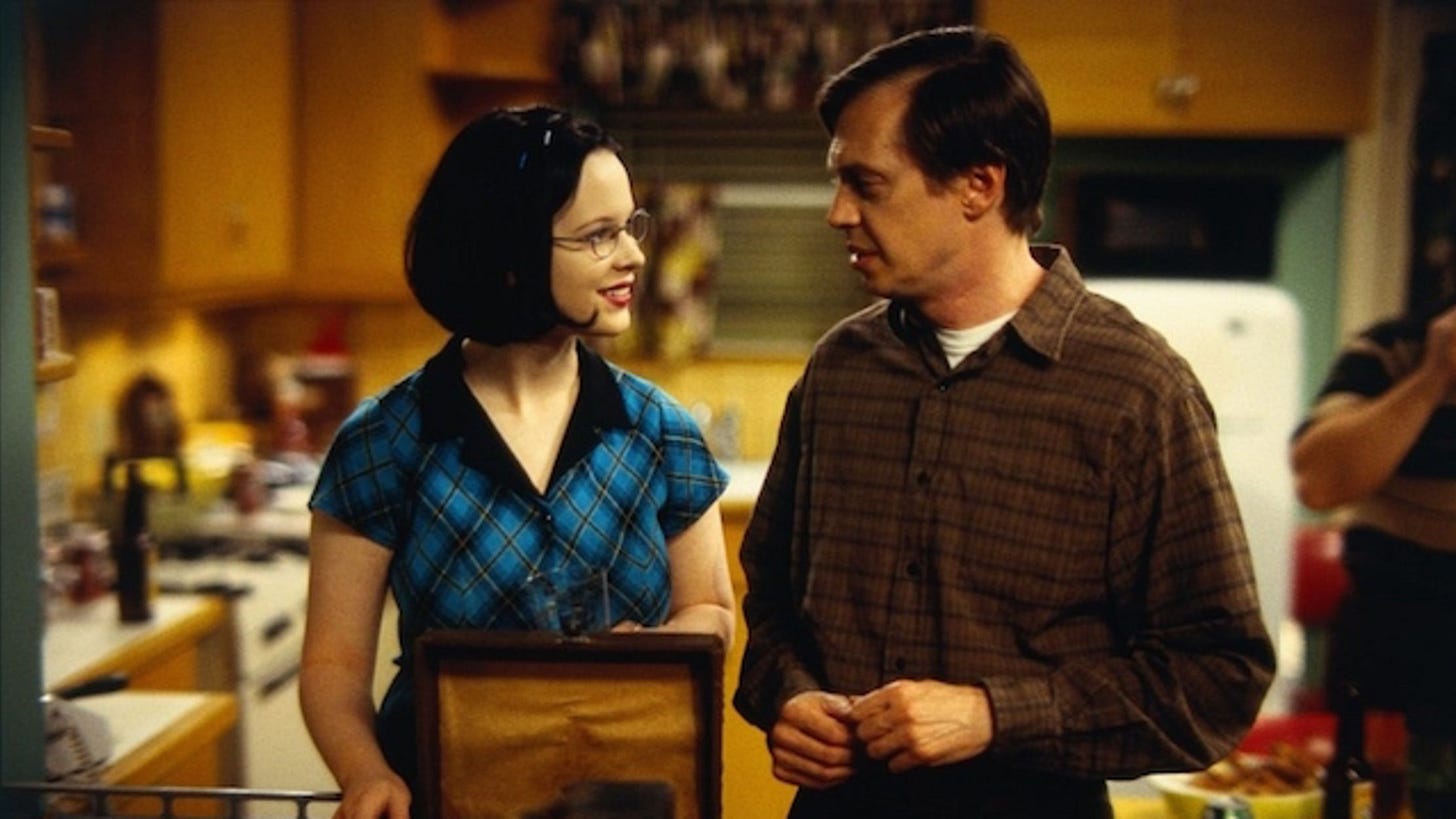In celebration of the 20th anniversary of Ghost World, for this week’s newsletter, I’ve written a short essay on what the film has meant to me over the past decade. My next newsletter will come out the week of August 23rd and it will be a more conventional book review. Please like, share, comment, and subscribe if you enjoyed it!
For a few years, Ghost World was the only movie I had on my laptop. I saw it for the first time in my mid-teens, hungry for anything that had a whiff of counterculture to it. I read the original comic by Daniel Clowes, borrowed from the library, and loved it so much I knew I had to see the movie. I got one of my friends to download it for me–she gave it to me on a purple-and-black 4GB USB stick. I transferred the file onto my laptop and watched it for the first time alone in my room, a viewing I would recreate once every two years over the next decade.
By the time I first watched Ghost World in 2011, it had already been in the cultural zeitgeist for ten years. Directed by Terry Zwigoff, who also made the documentary Crumb (and curiously, Bad Santa), the film was released in July 2001. It stars Thora Birch as Enid Coleslaw (an anagram for writer Daniel Clowes) and Scarlett Johanson as her best friend, Rebecca. The movie follows the pair during the summer after they graduate from high school. The viewer’s introduction to the two of them? Enid and Rebecca laughing at a girl giving a speech at their graduation, then giving the middle finger to their school building after the ceremony. The first time I saw them, I was hooked.
After graduation, Enid and Rebecca decide that instead of college, they’re going to get jobs and move in together. One afternoon while hanging out, they flip through the classifieds searching for apartments and find a missed connection for a “striking blonde with yellow dress, pearl necklace [and] brown shoes.” Rebecca suggests calling and pretending to be the blonde. Enid takes her up on the dare, telling the man on the other end of the line to meet them at a diner the next day. The man, played by Steve Buscemi, shows up, orders a vanilla milkshake, drinks the whole thing, realizes his date isn’t showing up and leaves. “Oh my God, this is totally unbearable,” Enid says, shrinking down in the booth as if he knows she’s responsible for setting him up.
The pair watch him leave the parking lot enraged and decide to follow him home to see where he lives. Later, they go back to his apartment and see that he’s having a garage sale. The man introduces himself as Seymour. Enid buys a blues record from him while Rebecca stands behind her and tries not to laugh at how pathetic he is. At home, Enid falls in love with the last song on the album, “Devil Got My Woman,” and goes back to Seymour’s apartment by herself to talk to him about it. From there, the two begin to spend more and more time together, much to the dismay of Rebecca, who gets a barista job and continues to look for an apartment for herself and Enid.
Watching Ghost World as a loser teen punk freak girl was nothing short of a revelation. While I had often seen loser teen punk freak boys shown on screen, Ghost World was the first time I saw a pair of loser teen punk freak girls star as the main characters of a movie. More than that, Enid and Rebecca reminded me of my friends and me. They wore vintage clothes and listened to old music no one else cared about. They talked in deadpan, monotone voices, constantly trying to one-up each other with their jokes. They knew they were weird, but they also knew that high school was hardly the best years of their lives, so they didn’t really feel that bad about it.
As a 15-year-old, I felt particularly connected to Enid. She had glasses and a brunette bob and doodled in her sketchbook constantly. She blasted The Buzzcocks in her bedroom and tried to recreate “an authentic 1977 punk rock look.” For all of high school, so did I. Rewatching the movie for this essay, I even realized that the outfit Enid wears to go to the sex store with Seymour–a vintage black collared blouse, a cheetah-print mini skirt, sheer tights, and Doc Martens–was one I currently had hanging up in my own closet.
It’s hard to articulate how much it meant for me to see a weirdo punk girl like Enid as the main character in a movie, especially now when I know how much more important it is for Hollywood to represent BIPOC and LGBTQ+ protagonists, not just white girls with glasses. Still, in my teen years, seeing Enid go through the entire film on her own terms, wearing the clothes she wanted, listening to the music she wanted, and making the (bad) decisions she wanted to was something I’d never seen before. Unlike other movies I’d seen with loser teen girls as main characters, there was never a scene where Enid got a makeover and had to take her glasses off like there was in The Princess Diaries or She’s All That. For better or for worse, Enid never changed herself to fit in with the rest of the world. It was an attitude I’d never seen a female character embody before, and it was something I desperately needed to see at the time.
With every rewatch in the past decade, however, I can’t help but start to see the cracks. Is Ghost World hard for me to watch as an adult because I’ve seen it so many times and already know how it ends? Or is that I see too much of my old self in Enid, a teenage girl who was mad at the world and didn’t know what to do with that anger besides directing it outwards?
While I was once smitten with her smart-ass jokes, now I can’t help but find Enid mean, even downright cruel. She and Rebecca nastily make fun of their classmates, using the r-slur and joking that one of their classmates is going to date-rape another and get AIDS (I hardly think I realized the weight of this insult as a 15-year-old). They constantly act inappropriately towards other people, for their own amusement, or because they’re bored–they follow strangers on the street, they harass their friend Josh at his job, and, of course, they pull the missed connections prank on Seymour and follow him home.
Enid’s relationship with Seymour is one of the most difficult parts to rewatch. If Enid and Rebecca are mean to their classmates and to strangers, they are absolutely vicious to Seymour, two decades their senior (“Yeah, he should totally just kill himself,” Rebecca says to Enid right after they meet him). After Seymour reveals that he hasn’t been on a date in four years, Enid promises to find a date, and the appropriateness of their “friendship” sharply declines from there.
Still, it’s Enid’s obliviousness when it comes to race and appropriation that is by far the most damning aspect of her character. Needing to submit a piece of art for her summer school class in order to graduate, Enid borrows a poster from Seymour that he took from Cook’s Chicken, the company he works for. The poster, an early logo for the franchise, depicts a racist caricature of a Black man’s face. Enid takes the poster and submits it to her art class as a “found object” piece for an assignment, as a comment on how racism used to be more out in the open. Her teacher’s reaction? Calling it a “remarkable achievement,” and offering Enid a one-year paid scholarship to a post-secondary art academy, all for something Enid didn’t create herself, and barely understands the weight and history behind.
I don’t know on what rewatch it was that I started to identify more with Rebecca than with Enid, but it was definitely sometime in my 20s. While Enid reminded me of myself in high school, Rebecca, with her blonde hair and 20/20 vision, still resembled the popular girls she and Enid made fun of. However, watching her character as an adult, I couldn’t help but see myself in her the same way I saw myself in Enid at 15. While Enid believes that she shouldn’t have to compromise at all to exist in the world, Rebecca, on the other hand, realizes that she must compromise in order to at least exist in the world comfortably.
While Enid avoids getting a job and looking for an apartment, Rebecca is the one who starts working as a barista and setting up viewings. Where she starts the film by wearing vintage dresses and miniskirts, as the film progresses, Rebecca starts wearing button-up blouses and slacks, looking like the “totally rich yuppie” she initially jokes about with Enid. When the pair go shopping for items for their apartment, Rebecca looks at a set of coloured plastic cups and says, “Aren’t these the greatest?” (I knew I was officially a grown-up when I started enjoying trips to HomeSense instead of dreading them). And when the two finally move into an apartment together, Rebecca tells Enid, “I have to show you something cool.” The something in question? An ironing board that pulls out of their kitchen wall.
I don’t know if identifying with Rebecca means that I’ve sold out, if I’ve been beaten down by life, or if I’ve just grown up. Even though I was once a spiteful teen interested only in punk rock and cult movies, I’m now an earnest adult with a day job and an apartment. I don’t exclusively wear vintage clothes and listen to hardcore cassettes anymore; sometimes I buy clothes from the mall and listen to pop music on Spotify. And while the existential dread of my teenage years continues in my 20s (there’s nothing like a global pandemic and the fear of climate collapse to completely kill the vibe of your youth), I'm generally content in my day-to-day life in a way that makes the intensity of my adolescent anger feel far removed.
I don’t have Ghost World on my laptop anymore. I lost it suddenly when mine crashed last year and never rebooted after years of chugging along. I bought a new laptop though, and a new sticker for the front of it, a sticker of two teenage girls wearing mini skirts, nearly brushing hands, with eyes that read, “Don’t you fucking try me.” At 15, I felt like one of them, and at 25, I felt like another.
At 40, I’ll probably relate the most to Seymour.










yikes i saw this in the theatre, so i have been experiencing it for its full 20 years! i find ghost world the movie weird in part because (imo) it is so deeply gen-x, and when the movie came out in 2001, based on comics from the mid-90s, it was already kind of a period piece.
also i think it is absolutely cool for your kitchen to have an ironing board that folds out, i believe enid to be wrong about this and pretty much everything else.